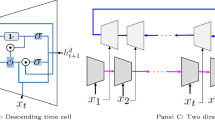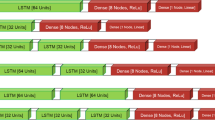Abstract
Taxis are one of the representative modes of traffic systems. However, with the emergence of shared cars led by DiDi and Uber in recent years, the traditional taxi companies are facing unprecedented competitions. Without personalized data collected from the mobile devices, passenger flow prediction based on vehicle GPS records presents a unique solution that can improve taxis’ operating efficiency while preserving personal privacy. In this paper, we propose the Travel Behavioral Inertia (TBI) from taxi GPS records, which embodies Driver Inertia (DI) and Passenger Inertia (PI). Then we integrate TBI with other features to construct multi-dimensional features and predict taxi passenger flow based on a deep learning algorithm. We call the entire framework TBI2Flow. Extensive experiments demonstrate that TBI features has outstanding contribution to passenger flow prediction and TBI2Flow outperforms state-of-the-art methods including time series-based method and other deep learning-based methods on long-term taxi passenger flow prediction.










Similar content being viewed by others
Notes
This method is not only simple, but also can meet the requirements of most traffic researches. Other methods embody Voronoi tessellation division based on particles and division based on urban road network framework. Researches with special spatial needs can consider the above two complex spatial division methods.
References
Abadi, M., Barham, P., Chen, J., Chen, Z., Davis, A., Dean, J., Devin, M., Ghemawat, S., Irving, G., Isard, M., et al.: Tensorflow: a system for large-scale machine learning. In: 12Th {USENIX} Symposium on Operating Systems Design and Implementation ({OSDI} 16), pp. 265–283 (2016)
Ahmed, M.S., Cook, A.R.: Analysis of freeway traffic time-series data by using Box-Jenkins techniques. 722 (1979)
Box, G.E., Jenkins, G.M., Reinsel, G.C., Ljung, G.M.: Time Series Analysis: Forecasting and Control. Wiley, New York (2015)
Chen, C., Jiao, S., Zhang, S., Liu, W., Feng, L., Wang, Y.: Tripimputor: real-time imputing taxi trip purpose leveraging multi-sourced urban data. IEEE Trans. Intell. Transp. Syst. (99):1–13 (2018)
Deng, Z., Ji, M.: Spatiotemporal structure of taxi services in Shanghai: Using exploratory spatial data analysis. In: International Conference on Geoinformatics, pp. 1–5 (2011)
Fei, X., Lu, C.C., Liu, K.: A bayesian dynamic linear model approach for real-time short-term freeway travel time prediction. Transportation Research Part C Emerging Technologies 19(6), 1306–1318 (2011)
Ferreira, N., Poco, J., Vo, H.T., Freire, J., Silva, C.T.: Visual exploration of big spatio-temporal urban data: a study of new york city taxi trips. IEEE Trans. Vis. Comput. Graph. 19(12), 2149–2158 (2013)
Glöss, M., McGregor, M., Brown, B.: Designing for labour: uber and the on-demand mobile workforce. In: Proceedings of the 2016 CHI Conference on Human Factors in Computing Systems, pp 1632–1643. ACM (2016)
Guo, F., Krishnan, R., Polak, J.: A computationally efficient two-stage method for short-term traffic prediction on urban roads. Transp. Plan. Technol. 36(1), 62–75 (2013)
Hamed, M.M., Al-Masaeid, H.R., Said, Z.M.B.: Short-term prediction of traffic volume in urban arterials. J. Transp. Eng. 121(3), 249–254 (1995)
He, J., Shen, W., Divakaruni, P., Wynter, L., Lawrence, R.: Improving traffic prediction with tweet semantics. In: International Joint Conference on Artificial Intelligence, pp. 1387–1393 (2013)
Hobeika, A.G., Chang, K.K.: Traffic-flow-prediction systems based on upstream traffic. In: Vehicle Navigation and Information Systems Conference, 1994. Proceedings, pp. 345–350 (2002)
Hou, Z., Li, X.: Repeatability and similarity of freeway traffic flow and long-term prediction under big data. IEEE Trans. Intell. Transp. Syst. 17(6), 1786–1796 (2016)
Huang, W., Song, G., Hong, H., Xie, K.: Deep architecture for traffic flow prediction: Deep belief networks with multitask learning. IEEE Trans. Intell. Transp. Syst. 15(5), 2191–2201 (2014)
Kong, X., Xu, Z., Shen, G., Wang, J., Yang, Q., Zhang, B.: Urban traffic congestion estimation and prediction based on floating car trajectory data. Futur. Gener. Comput. Syst. 61(C), 97–107 (2016)
Kong, X., Xia, F., Wang, J., Rahim, A., Das, S.K.: Time-location-relationship combined service recommendation based on taxi trajectory data. IEEE Trans. Ind. Inf. 13(3), 1202–1212 (2017)
Kong, X., Li, M., Li, J., Tian, K., Hu, X., Xia, F.: Copfun: an urban co-occurrence pattern mining scheme based on regional function discovery. World Wide Web, pp. 1–26 (2018)
Lee, J., Shin, I., Park, G.L.: Analysis of the passenger pick-up pattern for taxi location recommendation. In: International Conference on Networked Computing and Advanced Information Management, pp. 199–204 (2008)
Li, B., Zhang, D., Sun, L., Chen, C., Li, S., Qi, G., Yang, Q.: Hunting or waiting? discovering passenger-finding strategies from a large-scale real-world taxi dataset. In: IEEE International Conference on Pervasive Computing and Communications Workshops, pp. 63–68 (2011)
Liu, L., Andris, C., Biderman, A., Ratti, C.: Revealing taxi driver’s mobility intelligence through his trace. IEEE Pervasive Comput 160, 1–17 (2009)
Ma, J., Choo, K.K.R., Hsu, H.h., Jin, Q., Liu, W., Wang, K., Wang, Y., Zhou, X.: Perspectives on cyber science and technology for cyberization and cyber-enabled worlds. In: Dependable, Autonomic and Secure Computing, 14th Intl Conf on Pervasive Intelligence and Computing, 2nd Intl Conf on Big Data Intelligence and Computing and Cyber Science and Technology Congress (DASC/PiCom/DataCom/CyberSciTech), 2016 IEEE 14th Intl C, pp 1–9 (2016)
Ma, X., Tao, Z., Wang, Y., Yu, H., Wang, Y.: Long short-term memory neural network for traffic speed prediction using remote microwave sensor data. Transportation Research Part C: Emerging Technologies 54, 187–197 (2015)
Ni, M., He, Q., Gao, J.: Forecasting the subway passenger flow under event occurrences with social media. IEEE Trans. Intell. Transp. Syst. PP(99), 1–10 (2017)
Oh, S.D., Kim, Y.J., Hong, J.S.: Urban traffic flow prediction system using a multifactor pattern recognition model. IEEE Trans. Intell. Transp. Syst. 16(5), 2744–2755 (2015)
Ouyang, Y., Guo, B., Lu, X., Han, Q., Guo, T., Yu, Z.: Competitivebike: Competitive analysis and popularity prediction of bike-sharing apps using multi-source data. IEEE Trans. Mob. Comput. (2018)
Su, F., Dong, H., Jia, L., Qin, Y., Tian, Z.: Long-term forecasting oriented to urban expressway traffic situation. Adv. Mech. Eng. 8(1). https://doi.org/10.1177/1687814016628397 (2016)
Vlahogianni, E.I., Golias, J.C., Karlaftis, M.G.: Short-term traffic forecasting: Overview of objectives and methods. Transp. Rev. 24(5), 533–557 (2004)
Voort, M.V.D., Dougherty, M., Watson, S.: Combining kohonen maps with arima time series models to forecast traffic flow. Transportation Research Part C Emerging Technologies 4(5), 307–318 (1996)
Wang, D., Cao, W., Li, J., Ye, J.: Deepsd: Supply-demand prediction for online car-hailing services using deep neural networks. In: 2017 IEEE 33rd International Conference on Data Engineering (ICDE), pp 243–254. IEEE (2017)
Wang, J., Shi, Q.: Short-term traffic speed forecasting hybrid model based on chaosĺcwavelet analysis-support vector machine theory. Transportation Research Part C Emerging Technologies 27(2), 219–232 (2013)
Wang, Y., Papageorgiou, M., Messmer, A.: Real-time freeway traffic state estimation based on extended kalman filter: a case study. Transp. Sci. 41(2), 167–181 (2007)
Williams, B., Durvasula, P., Brown, D.: Urban freeway traffic flow prediction: Application of seasonal autoregressive integrated moving average and exponential smoothing models. Transp. Res. Rec. 1644(1), 132–141 (1998)
Williams, B.M., Hoel, L.A.: Modeling and forecasting vehicular traffic flow as a seasonal arima process: Theoretical basis and empirical results. J. Transp. Eng. 129 (6), 664–672 (2003)
Wu, C.H., Ho, J.M., Lee, D.T.: Travel-time prediction with support vector regression. IEEE Trans. Intell. Transp. Syst. 5(4), 276–281 (2004)
Xia, F., Rahim, A., Kong, X., Wang, M., Cai, Y., Wang, J.: Modeling and analysis of large-scale urban mobility for green transportation. IEEE Trans. Ind. Inf. 14(4), 1469–1481 (2018)
Xia, F., Wang, J., Kong, X., Wang, Z., Li, J., Liu, C.: Exploring human mobility patterns in urban scenarios: a trajectory data perspective. IEEE Commun. Mag. 56(3), 142–149 (2018)
Yang, H.F., Dillon, T.S., Chen, Y.P.: Optimized structure of the traffic flow forecasting model with a deep learning approach. IEEE Transactions on Neural Networks and Learning Systems PP(99), 1–11 (2016)
Yuan, J., Zheng, Y., Xie, X., Sun, G.: T-drive: Enhancing driving directions with taxi drivers. IEEE Trans. Knowl. Data Eng. 25(1), 220–232 (2013)
Yue, Y., Zhuang, Y., Li, Q., Mao, Q.: Mining time-dependent attractive areas and movement patterns from taxi trajectory data. In: International Conference on Geoinformatics, pp. 1–6 (2009)
Zhang, F., Zhang, L.: Regulation of car-hailing against the background of “Internet Plus” in China. In: 2017 2nd International Seminar on Education Innovation and Economic Management (SEIEM 2017), Atlantis Press (2017)
Zhang, J., Zheng, Y., Qi, D., Li, R., Yi, X.: Dnn-based prediction model for spatio-temporal data. In: Proceedings of the 24th ACM SIGSPATIAL International Conference on Advances in Geographic Information Systems, p 92. ACM (2016)
Zhang, L., Lu, J., Zhou, J., Zhu, J., Li, Y., Wan, Q.: Complexities’ day-to-day dynamic evolution analysis and prediction for a didi taxi trip network based on complex network theory. Mod. Phys. Lett. B 32(09), 1850,062 (2018)
Zhao, J., Sun, S.: High-order gaussian process dynamical models for traffic flow prediction. IEEE Trans. Intell. Transp. Syst. 17(7), 2014–2019 (2016)
Zhou, X., Bo, W., Jin, Q.: Analysis of user network and correlation for community discovery based on topic-aware similarity and behavioral influence. IEEE Transactions on Human-Machine Systems PP(99), 1–13 (2017)
Zhou, X., Liang, W., Kevin, I., Wang, K., Huang, R., Jin, Q.: Academic influence aware and multidimensional network analysis for research collaboration navigation based on scholarly big data. IEEE Trans. Emerg. Top. Comput. (2018)
Zhou, X., Zomaya, A.Y., Li, W., Ruchkin, I.: Cybermatics: Advanced strategy and technology for cyber-enabled systems and applications (2018)
Acknowledgments
The authors extend their appreciation to the Deanship of Scientific Research at King Saud University for funding this work through research group No. RG- 1439-088. This work was partially supported by the National Natural Science Foundation of China (61572106), the Dalian Science and Technology Innovation Fund (2018J12GX048), and the Fundamental Research Funds for the Central Universities (DUT18JC09).
Author information
Authors and Affiliations
Corresponding author
Additional information
Publisher’s note
Springer Nature remains neutral with regard to jurisdictional claims in published maps and institutional affiliations.
This article belongs to the Topical Collection: Special Issue on Smart Computing and Cyber Technology for Cyberization
Guest Editors: Xiaokang Zhou, Flavia C. Delicato, Kevin Wang, and Runhe Huang
Rights and permissions
About this article
Cite this article
Kong, X., Xia, F., Fu, Z. et al. TBI2Flow: Travel behavioral inertia based long-term taxi passenger flow prediction. World Wide Web 23, 1381–1405 (2020). https://doi.org/10.1007/s11280-019-00700-1
Received:
Revised:
Accepted:
Published:
Issue Date:
DOI: https://doi.org/10.1007/s11280-019-00700-1




